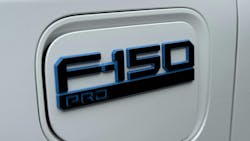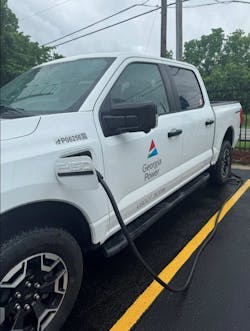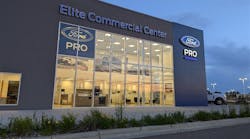Managing peak grid demand with demand response and staggered EV charging
Ford Pro and Southern Company’s pilot also sought to test the effectiveness of pausing vehicle charging at times when the grid was strained.
Gupta explained that each time these vehicles charge, they consume energy from the grid. If these EVs all charge at scale, that energy puts significant strain on the grid. The Ford Pro team sought to mitigate this strain proactively, Gupta said.
Using technology similar to dynamic charging, which allows the vehicle to accept charge at specific times, demand response can prevent the vehicle from pulling charge when excessive stress is placed on the grid.
“We can take a signal from the grid and say, ‘OK, can you stop charging for a certain time on these assets so that energy can be used somewhere else?’” Gupta said.
While this likely won’t affect your average commercial fleet, managing charging in this way benefits Southern Company by ensuring the electricity it provides is used for essential services across its network, not for its own fleet vehicles.
Using Southern Company’s expertise, the two parties determined the best times to test demand response charging. They tested this at three different times of the day when Southern Company indicated a high demand on grid activity (think: peak times).
Ford Pro then planned for these events within its charging platform, enabling the chargers to receive signals from the grid and ensuring the charging pause and charging restart would happen seamlessly with no human intervention. The pilot proved successful.
“We did three demand response events at different times of the day for different hours, but all of them delivered consistent and verifiable load reductions” on the grid, Gupta said. “In one of the events, we dropped half a megawatt of power from the grid within minutes. That [power] could be redeployed elsewhere or reduce the strain on the grid.”
That half megawatt was reduced by delaying charging for just Southern Company’s fleet. Gupta stressed that the effect could be much more if all EV fleets staggered their charging in this way.
But just because charging these vehicles is made a lesser priority for the grid at a certain time, this doesn’t mean they were neglected. In fact, the goal of this pilot was to ensure no impact on fleet uptime. Through this pilot, Ford Pro and Southern Company found that these vehicles were sufficiently charged and ready for work even with the staggered charging. Gupta put it this way:
“We made sure there was no problem as we did [demand response charging],” he said. Once the demand event was over, “the vehicle started charging again. The charger responded accurately. There was no drop-off in terms of someone needing to come in and plug charging again. It just happened seamlessly, and it was invisible to anyone at the back end. It didn't impact their operations, but it was like a small intervention that we did and tried to see what would happen. It worked really well."
Ensuring fleet uptime while implementing staggered and managed EV charging
Staggered charging or pausing EV charging might leave a fleet owner, manager, or driver skeptical. What if it doesn’t charge enough to be ready for work when you are? Thankfully, Gupta said Ford Pro chargers recognize when a vehicle’s battery is too low and—if the vehicle needs to be charged by a specific time the next day—won’t interfere with charging if it could jeopardize vehicle uptime.
While the pilot with Southern Company was particular to Southern Company’s fleet, Gupta believes the information gathered and data received from the pilot can help other fleets.
“The lessons and the data from this pilot allow us to tailor-manage charging to each [fleet],” Gupta explained. “Our team has already begun applying these learnings with a large national customer where our energy management platform is driving measurable savings without sacrificing uptime—and that’s the key. Scale isn’t about one-size-fits-all. It's all about using the foundation we've built to adapt intelligently.”
Managed charging also has the potential to enable electric fleet vehicles to reach cost parity with gas-powered fleet vehicles, as charge management software prevents vehicles from charging when rates are highest, as long as uptime allows.
Throughout the pilot, Southern Company was able to reduce its charging demand by half a megawatt during a 30-minute demand response event, and its chargers improved efficiency by approximately 10 kW per charger. That’s a savings that fleets can take to their bottom line.




